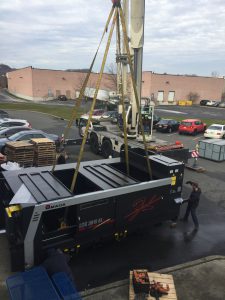Article Revised August 23rd, 2022
 CO2 lasers and fiber lasers are both important cutting technologies in metal fabrication, but they offer distinctly different advantages and disadvantages for fabricators.
CO2 lasers and fiber lasers are both important cutting technologies in metal fabrication, but they offer distinctly different advantages and disadvantages for fabricators.
CO2 Lasers: Pros and Cons
CO2 cutting lasers are an older type of laser technology, which means that, in general, the price to acquire them has come down over time, making them more affordable. Yet, it’s a technology that has continued to evolve beautifully, even as prices fall. While not as fast as their fiber laser cousins, CO2 lasers are extremely flexible and adaptable for use on the most common types of materials, such as aluminum and steel, and on a range of material thicknesses.
Although this may change over time, today’s CO2 lasers will generally perform better than fiber lasers on thicker materials, which is an important consideration for any fabricator considering purchasing a new cutting laser. However, if their projects don’t generally involve more intricate work on thinner metals, then putting the extra capital toward a fiber laser may not make much sense.
Fiber Lasers: Pros and Cons

Fiber lasers are still a newer laser cutting technology and are considerably more expensive than CO2 lasers. They have yet to reach the kind of critical mass required to start seeing significant drops in pricing.
While fiber laser technology is simply out of reach at this time for many smaller fabrication shops due to its high cost, for those who can afford them, they are worth every penny of the investment.
Lightning fast and exceptionally precise, fiber lasers can cut even the thinnest materials with incredible accuracy, including copper and brass. Fiber lasers are also efficient; in fact, EVS Metal’s Amada LCG 3015 AJ fiber laser runs on ⅓ of the electricity required by the same wattage CO2 laser system, which is three times more efficient with the electricity it does use. This type of laser also tends to be more compact, which means it takes up less valuable job shop floor space than most CO2 lasers.
Fiber Lasers vs CO2 Lasers: Which is Better?
Although there is a little bit of friendly “competition” between CO2 lasers and fiber lasers, the truth is that one cutting technology isn’t necessarily better than the other. Each has its own set of strengths and even a few weaknesses, depending on the intended application and environment (not to mention the associated budget considerations). Although we can’t choose one over the other right now, if and when fiber laser prices decrease, let’s just say that may be an entirely new ballgame.
EVS Metal is an American precision metal fabricator headquartered in Riverdale, NJ. Our machinists and operators utilize the latest technology to cut, bend and finish stand-alone items as well as parts for integration or assembly into more complex products. Our four ISO 9001:2015-certified locations comprise over 250,000 square feet of vertically-integrated manufacturing space and feature the most modern equipment available, from lasers and CNC machining centers to automated powder coating lines. We serve a diverse customer base across North America, providing a range of services from quick-turn prototypes to high-volume production runs. Request a personalized metal fabrication quote online, or call (973) 839-4432 to speak with a specialist today.





